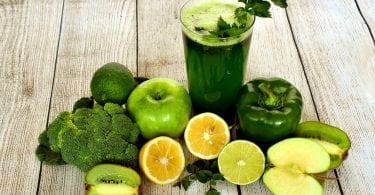In case you hadn’t noticed, juicing has become one of the most popular fads of 2014. Initially a big hit with celebrities such as Miranda Kerr and Gwyneth Paltrow who preached about the benefits of downing green lime, there is now a growing cult following of mere mortals.
Health fiends flock to juice bars. Vitamixes, Nutribullets and Magimixes are topping birthday and Christmas wish lists, with sales of juicers rising by 60 per cent in John Lewis over the past year. The person next to you at work is doing a 5 day cleanse. It’s official. Juicing has become an unstoppable force.
Juice vs smoothie
For those of you who don’t know the difference between a juice and a smoothie, let me explain. A smoothie is made in a blender with whole fruits and vegetables, end result being a thick and filling shake, fibres and all. Juicing involves a liquid extractor that separates both the juice and the pulp into different compartments, leaving you with a fibre-free drink.
You simply throw your chosen ingredients down a chute and seconds later, voila! This apparently gives your digestive system a ‘rest’ whilst providing your body with vitamins and nutrients. The perks of juices and smoothies are documented just about everywhere, from diet books to healthy lifestyle magazines – the trend is hard to miss.
But the question is, should the extraordinary publicity be clouding our judgement? Are we ignoring the health risks?
Green doesn’t mean good
Don’t be fooled by the pond-water shade of green you’re drinking. It looks healthy, and whilst it’s a healthier option than a Big Mac, juices and smoothies are secretly packed with sugar. An orange juice has the same level of sugar as a 13 McVitites chocolate Hobnobs. But they have so many vegetables in them, how is that possible?
Most vegetable smoothies have a fruit ‘base’ to add sweetness. Therefore many are deceptively calorific. On top of that, over indulgence can have multiple side effects on both your body and your teeth. Drinking your juice slowly (as the pros recommend) can cause enamel damage and tooth decay due to the high concentration of fructose sugar and acids.
Damage wise, you may as well be drinking a fizzy drink. There are also links to diabetes and heart disease. Charming. Whilst it is all well and good getting your 5-a-day in as tasty drink, people tend to forget that variety is a key part of having a healthy diet. Many juice fanatics stick to staple recipes that can be limiting. Instead, juice should be incorporated into a normal, healthy diet.
Top tips
In the grand scheme of unhealthy foods and drinks things, juices and smoothies are not going to leave you toothless and squidgy unless you drink them religiously Jason Vale style (without the compulsive marathon running). Yes there are hidden dangers, but there are ways to avoid them. Stick to the rule of everything in moderation, and if you are going to go big on juices, try one of the fruit free recipes below to avoid sore teeth and sinking into a sugar coma:
Tomato Juice:
3 cups chopped tomatoes
1 stalk celery
1 cucumber
3 drops Stevia (optional)
1/2 teaspoon Himalaya sea salt
Cayenne pepper
Green Smoothie:
½ organic cucumber, chopped
¼ cup parsley
½ lemon, peeled
½ avocado, pitted and peeled
2 cups organic, raw spinach
1 cup coconut water
6 ice cubes
Have you got any simple and healthy juice recipes to share? Comment below!








